
|

|
Pergamum (Pergamon) , Turkey
|
|
|
|
Pergamum, is the place where the general of Alexander the Great,
Lysimachus, deposited all his wealth after his death. He chose
Pergamum as the place to deposit the wealth. He placed all the
wealth under the custody of his lieutenant, Philetaerus. However, after
the king’s death, his lieutenant used his wealth and created the
independent dynasty of Attalid Kings which was then used as a center of
Hellenistic civilization. The two kings of the Hellenisitic
civilization, Attalus I and Eumenes II were very successful and Pergamum
prospered a lot and was on cloud 9. It was during that time, that the
Hellenisitic and Roman leaders united in power and made the |
|
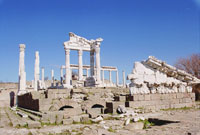 |
|
kingdom of Pergamum even more powerful... |
| |
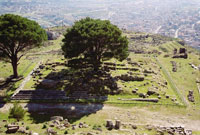 |
|
Pergamum became a large kingdom ruled by the king Attalus I who
extended the borders spent lavishly on the decoration of the place with
architectural glories. On the other hand, king Eumenes II brought some
great cultural improvements in the kingdom. After that, King Attalus III
gave the city of Pergamum to Romans who decorated the city
further with their rich taste of art and architecture but it became poor
in economy and politics. After that, the city of Pergamum went through
different periods and rules under the Arabs, Byzantine and at last the
Turkish in 14 AC. This city was very famous as a school of sculptures
during the Hellenistic period. It made a huge progress |
|
intellectually and architecturally as new monuments and building were
created. Pergamum, during the Roman period, it played a very
important part. |
|
|
| The daily
life in Pergamum consisted of many social and cultural
activities. Hence, in Pergamum all the buildings constructed there were
being used in daily life. Socialization was important even more than
religion and people used to gather in these places. In fact, in Pergamum
these places were built for that purpose only. Even the Pergamum temples
were served as meeting places where people could join in social and
cultural affairs. Pergamum was famous for being the first city that approved
and worked for urbanism. In fact, all the acropolis buildings created
there were made with the intention to impress the people in the valley. |
|
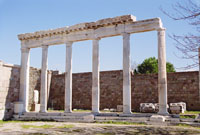 |
| |
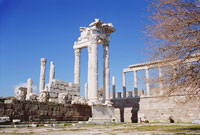 |
|
Buildings in Pergamum
All the buildings in Pergamum were built in Hellenistic period
other than the Trajan Temple and all the buildings were made with
andesite. Marble was used very rarely in Pergamum for construction. The
famous kings Attalus I and Eumenes II were worshipped in the Heroon
shrine. The Sanctuary of Athena in Pergamum was built by the king
Eumenes as a dedication to victory-bringing. The Athena Temple was also
built by Eumenes II and it was situated at the corner near the theater
at Pergamum. |
|
The library of Pergamum was also
built by the same kin which is still found today in ruins. Pergamum
library was among the three popular ancient librabries. It consisted of
200,000 volumes.. |
|
|
| These
volumes were given as a gift to Cleopatra by Mark Antony after a
century. These volumes were then added to the library of Alexandria. The
Pergamum library was enriched with sources but after the
prohibition of the export of papyrus, the king ordered another material
to replace papyrus. They found the new material to be parchment which
was made with sheep or goat skin. This material was first polished and
then it was cut into sheets. In Pergamum The temple of Trojan was built
in the 2nd century by Hadrian. The temple was dedicated to Trojan who
was the ancestor of Hadrian. The temple was entirely made up of marble. |
|
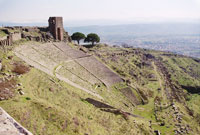 |
|
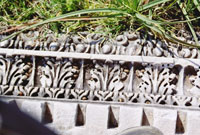 |
|
Other
famous building is Theatre of Pergamum which symbolizes
the Hellenistic taste of art and culture. It has eighty rows of seats
and is designed to accommodate 10,000 people. One can see the
Hellenistic type of theater in it as there is no permanent stage
structure and the audience could see the outside environment also.
Zeus Altar (Pergamum Altar) was built in 180 BC and it is
considered to be the finest altar in the world. It is entirely made of
marble. However, this alter did not have any temple. |
| |
Pergamum Asclepion
Pergamum Asclepion was an important health center during the Greco-Roman
times. Many types of therapy were practices here including mud baths,
theater, sports, psychotherapy and medicinal waters were used. The
Pergamum Asclepion was led by a colonnaded street and it has a temple
beside it. The temple was beautifully constructed and had thick walls
and high ceilings and domes. It was made in the year 150. The inerior of
the Pergamum temple was made up with multi-colored marble mosaics which
was the reason of its beauty and charm. It had art galleries on three
sides on the walls. There was a passage that went to the sacred spring
and it was known that therapies were done here with the sound of running
water that cured the patients. |
|
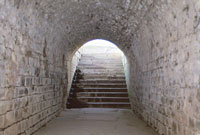 |
|
|
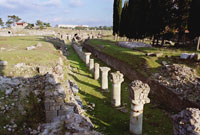 |
|
In
Pergamum, a
colonnaded street leads to the Asclepion, and to the left of the entrance
is the temple of Pergamum Asclepios. This domed Pergamum temple with its exceptionally thick
3m walls was built in 150 AD, with donations made to the god of health.
The interior was decorated with colorful marble mosaics, and surrounded by
galleries on three sides, the Asclepion has a passageway running through
the center alongside the sacred spring towards the therapy building. It is
thought that patients were cured here by the sound of running water and by
the persuasive hypnotic techniques used by the priests. |
|
|
The Temple of
Serapis - The Red Basilicaca
Another famous building in Pergamum is the temple of Serapis, the Red Basilica. This
is a temple entirely made of red brick and was dedicated to the gods of
Egypt. You can see the ruined temple now in Pergamum.
During the Byzantine period, this temple was converted into a church and
was renovated extensively. The church was devoted to the Apostle John.
It was then turned into a mosque and you can see the remains of the
mosque even now. The
fact that it faces west, and is decorated with statues in an Egyptian
style, indicates that it was possibly presented to Serapis, the Egyptian
god of |
|
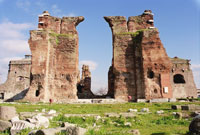 |
|
the underworld. Pergamum, in the Byzantine period, it was turned into a
church by extensive remodeling, especially to the apse sections, and was
dedicated to the Apostle John. |
|
 |
|
In
early Christianity, Pergamum was one of the Seven Churches of Asia Minor
addressed by St John in the Book of Revelation, who referred to it as the
throne of the Devil. In Pergamum, although a crumbling ruin, it still contains the
remains of a mosque.Pergamum
- Is worth seing..
|
|
|
|
|
|
 Rated: 9.8
out of 10
by 343
Reviews
Rated: 9.8
out of 10
by 343
Reviews
|
|
|
Pages |
Ads |
|
|
|
|










